Grantee Research Project Results
Final Report: Ensemble Analyses of the Impact and Uncertainties of Global Change on Regional Air Quality in the U.S.
EPA Grant Number: R833369Title: Ensemble Analyses of the Impact and Uncertainties of Global Change on Regional Air Quality in the U.S.
Investigators: Lamb, Brian , Mass, Clifford , Guenther, Alex , Wiedinmyer, Christine , Salathe, Eric , McKenzie, Donald , Chung, Sandra
Institution: Washington State University , National Center for Atmospheric Research , University of Washington , USDA
EPA Project Officer: Chung, Serena
Project Period: February 1, 2007 through January 31, 2011 (Extended to January 31, 2012)
Project Amount: $899,987
RFA: Consequences of Global Change For Air Quality (2006) RFA Text | Recipients Lists
Research Category: Air , Climate Change
Objective:
This project builds on results from a previous EPA global change project (RD8383096, Chen, et al., 2009a,b; Avise, et al., 2009). Our overall goal was to answer questions, as initially posed in our previous project, related to the effects of global change on regional air quality, to include quantitative estimates of uncertainties as part of the answers to our research questions, and to present our results specifically in terms appropriate for air quality regulatory needs. The overall research questions include: How will global change affect regional air quality in the future? How are biogenic emissions affected by global climate change and land management practices and thus affect air quality? How will changes in emissions in Asia impact U.S. air quality? How will the role of fire change with respect to regional air quality in the future? How will global change affect atmospheric deposition in sensitive ecosystems?
Our objectives evolved through the course of the project to include: 1) assessment of the relative importance of the effects of local U.S. emission changes, climate change, land use change, and increasing Asian emissions upon future air quality in the continental United States; 2) development and application of a relative response factor (RRF) approach similar to that used for state implementation plan (SIP) model analyses modified to include a climate impact factor; 3) analysis of Policy Relevant Background simulations for the United States, and 4) analysis and projection of modeling uncertainties through a limited ensemble analysis approach. The latter objective involves analysis of results from various model configurations and using both ECHAM5 and CCSM3 global output for A1B and B1 scenarios. This portion of the work is not complete and will not be addressed in this report.
Summary/Accomplishments (Outputs/Outcomes):
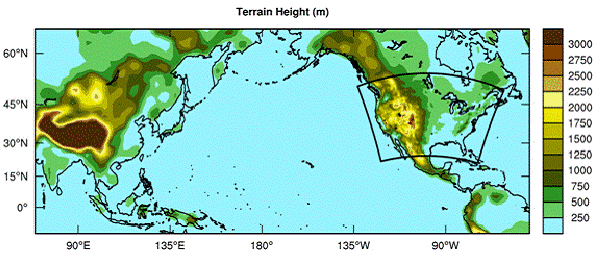
- POET inventory (Olivier, et al., 2003; Granier, et al., 2005) for reactive gases
- SO2 from EDGAR 32FT200 (Olivier and Berdowski, 2001)
- Primary organic aerosol and black carbon from Bond, et al. (2004)
- 2050 projection factors from David Streets
- NEI 2002 for the current decade
- Emission Projection Scenario (ESP) based on MARket Allocation energy system model assuming current regulatory curtailment extended through 2050 (Loughlin, et al., 2011)
- Future cropland data based on IMAGE 2100 global cropland extent data, the SAGE maximum cultivable land data, and the MODIS cropland data
- Plant functional type (PFT) for broadleaf, conifer, shrubs and grasses were projected using Mapped Atmosphere-Plant-Soil System (MAPSS) model output (http://www.fs.fed.us/pnw/mdr/mapss/, Neilson, 1995) based on three GCM future scenarios.
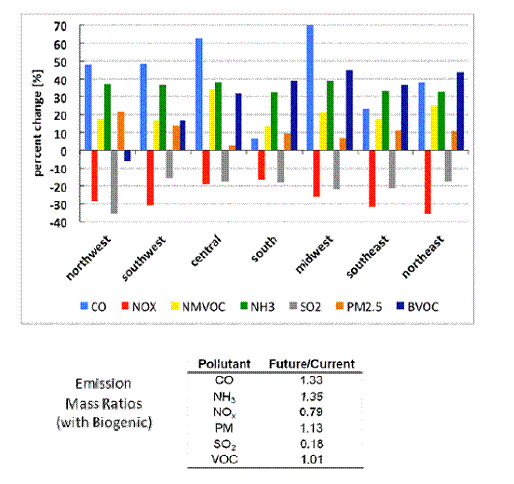
| Case | Climate | Biogenic Emissions | Anthropogenic Emissions |
| Climate Land Use | US Global | ||
| CD_Base | Current | Current Current | Current Current |
| A1B_Met | Future | Current Current | Current Current |
| A1B_M | Future | Future Current | Current Current |
| A1B_M_LU | Future | Future Current | Current Current |
| A1B_US | Current | Current Current | Future Current |
| A1B_BC | Current | Current Current | Current Future |
| A1B_Base | Future | Future Future | Future Future |

| Regions | CD_Base | A1B_Base | A1B_US | A1B_BC | A1B_Met | A1B_M | A1B_M_LU |
| Northwest | 73 (43) | 2 (1) | 2 (0) | 2 (3) | -7 (-1) | 1 (-1) | 2 (-1) |
| Southwest | 106 (62) | -4 (0) | -6 (-4) | 3 (5) | -3 (0) | 0 (0) | -3 (-1) |
| Central | 80 (54) | 5 (4) | -5 (-2) | 3 (5) | 6 (3) | 7 (2) | 8 (2) |
| South | 107 (60) | 3 (6) | -2 (-2) | 1 (4) | 1 (5) | 5 (5) | 4 (5) |
| Midwest | 123 (72) | 6 (4) | -5 (-3) | 1 (2) | 8 (6) | 13 (6) | 10 (6) |
| Southeast | 103 (66) | -2 (1) | -10 (-5) | 1 (2) | 7 (6) | 7 (5) | 8 (5) |
| Northeast | 135 (75) | 4 (2) | =9 (-5) | 1 (1) | 7 (6) | 16 (7) | 15 (7) |
| Regions | CD_Base | A1B_Base | A1B_US | A1B_BC | A1B_Met | A1B_M | A1B_M_LU |
| Northwest | 12.2 (3.3) | 0.0 (-0.1) | -1.2 (-0.3) | 0.0 (0.0) | 0.9 (0.3) | 1.1 (0.3) | 1.1 (0.3) |
| Southwest | 23.6 (6.6) | 2.5 (0.4) | 0.2 (-0.1) | 0.3 (0.1) | 1.6 (0.4) | 1.8 (0.4) | 1.8 (0.4) |
| Central | 5.9 (1.8) | 1.3 (0.0) | -1.0 (-0.3) | 0.0 (0.0) | 0.0 (0.0) | 0.5 (0.1) | 2.2 (0.3) |
| South | 13.3 (4.7) | 3.9 (0.7) | -1.7 (-0.4) | 0.1 (0.1) | -0.5 (-0.1) | 1.9 (0.5) | 5.2 (1.2) |
| Midwest | 16.1 (6.3) | 5.5 (0.7) | -1.7 (-0.9) | 0.0 (0.0) | 0.3 (0.2) | 2.5 (0.6) | 6.6 (1.7) |
| Southeast | 16.8 (6.9) | 9.5 (1.9) | -0.1 (-0.4) | 0.0 (0.0) | 0.1 (0.2) | 4.8 (1.3) | 9.4 (2.4) |
| Northeast | 28.9 (8.7) | -2.8 (-0.2) | -7.5 (-1.3) | 0.2 (0.0) | -0.1 (0.1) | 1.2 (0.5) | 3.8 (1.2) |
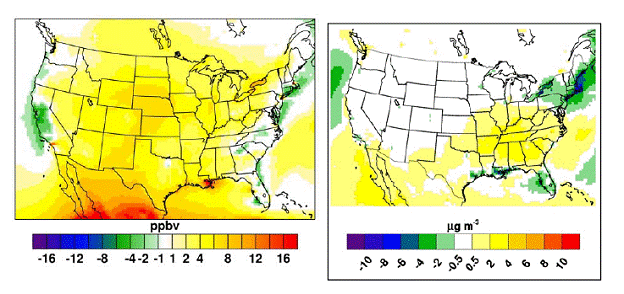
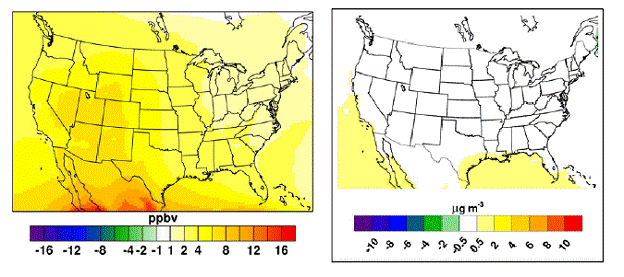
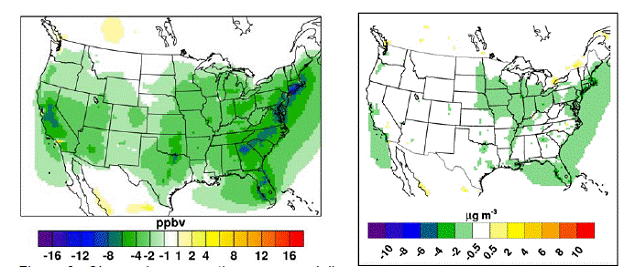
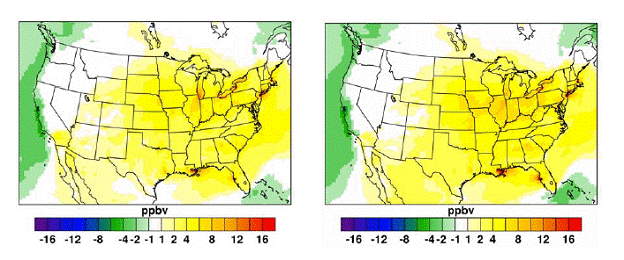 .
.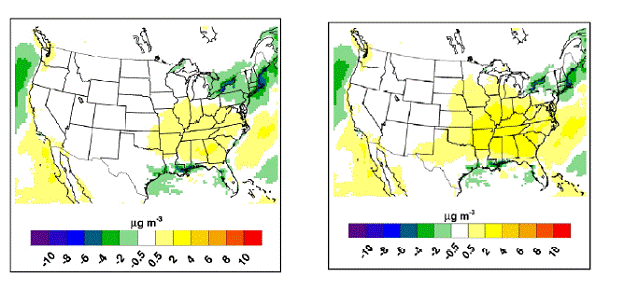



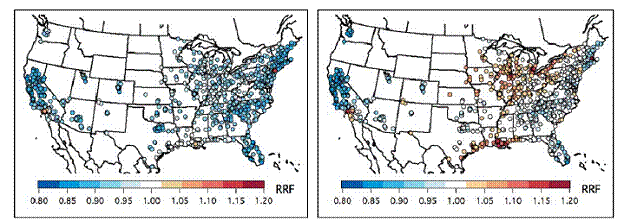
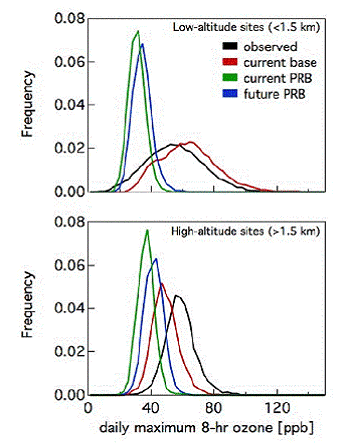
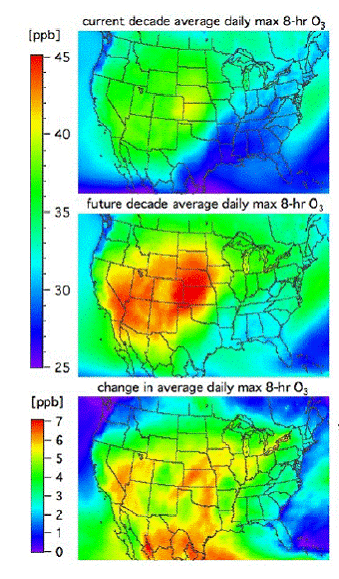
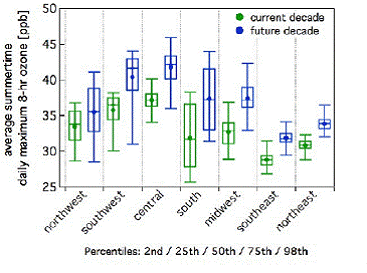
| Regions | CD_ICCO_PRB | A1B_ICCO_PRB |
|---|---|---|
| Northwest | 36 | 5 |
| Southwest | 37 | 5 |
| Central | 40 | 5 |
| South | 39 | 6 |
| Midwest | 37 | 6 |
| Southeast | 31 | 3 |
| Northeast | 32 | 4 |
Conclusions:
- Overall O3 increases by a few ppb across most of the United States.
- Effects of climate, biogenic, land-use & global emission changes generally increase O3 and this increase is somewhat offset by reduction of U.S. anthropogenic emissions.
- By increasing biogenic emissions, climate warming leads to an increase in SOA, which more than offsets the reduction in PM2.5 achieved through future emissions controls in the Southeast and parts of the Northeast. The increase in SOA is enhanced when future cropland expansion is considered.
- A Relative Reduction Factor analysis documented the climate penalty associated with future ozone, and shows that in many cases projected emission changes are not sufficient to achieve a reduction in ozone concentrations under future climate conditions.
- Analysis of Policy Relevant Background ozone concentrations yields levels that range from 30 to 45 ppb across the United States, and which are projected to increase by approximately 4 ppb in the 2050s with some regions experiencing an increase of as much as 6-7 ppb.
References:
Avise, J., J. Chen, B. Lamb, C. Wiedinmyer, A. Guenther, E. Salathé, and C. Mass, 2009. Attribution of projected changes in summertime US ozone and PM2.5 concentrations to global changes. Atmospheric Chemistry and Physics 9:1111-1124. SRef-ID: 1680-7324/acp/2009-9-1111.
Avise, J., R. G. Abraham, S. H. Chung, J. Chen, B. Lamb, E. P. Salathé, Y. X. Zhang, C. G. Nolte, D. H. Loughlin, A. Guenther, C. Wiedinmyer, and T. Duhl, 2012. Evaluating the effects of climate change on summertime ozone using a Relative Response Factor approach for policy makers. Journal of the Air & Waste Management Association, accepted for publication.
Bond, Tami C., D. G. Streets, K. F. Yarber, S. M. Nelson, J. H. Woo, and Z. Klimont, 2004. A technology-based global inventory of black and organic carbon emissions from combustion, Journal of Geophysical Research-Atmospheres 109:D14203, doi:10.1029/2003JD003697.
Chen, J., Avise, J., Lamb, B., Salathé, E., Mass, C., Guenther, A., Wiedinmyer, C., Lamarque, J.-F., O'Neill, S., McKenzie, D., and Larkin, N, 2009. The effects of global changes upon regional ozone pollution in the United States. Atmospheric Chemistry and Physics 9:1125-1141.
Chen, J. J. Avise, A. Guenther, C. Wiedinmyer, E. Salathe, R. Jackson, and B. Lamb, 2009. Future land use and land cover influences on regional biogenic emissions and air quality in the United States. Atmospheric Environment 43:5771-5780.
Guenther, A., T. Karl, P. Harley, C. Wiedinmyer, P. I. Palmer, and C. Geron, 2006. Estimates of global terrestrial isoprene emissions using MEGAN (Model of Emissions of Gases and Aerosols from Nature). Atmospheric Chemistry and Physics 6:3181-3210, doi:10.5194/acp-6-3181- 2006.
Granier, C., J. F. Lamarque, A. Mieville, J. F. Muller, J. Olivier, J. Orlando, J. Peters, G. Petron, G. Tyndall, and S. Wallens, 2005. POET, a database of surface emissions of ozone precursors. http://www.aero.jussieu.fr/project/ACCENT/POET.php (accessed April 8, 2012).
Loughlin, D. H., W. G. Benjey, and C. G. Nolte, 2011. ESP V1.0: Methodology for exploring emission Impacts of future scenarios in the United States. Geoscientific Model Development 4, 287-297.
Olivier, J. G. J. and J. J. M. Berdowski, 2001. Global emissions sources and sinks. In: Berdowski J., Guicherit, R. and B. J. Heij (eds.) “The Climate System”, Lisse, The Netherlands: A.A. Balkema Publishers/Swets & Zeitlinger Publishers, pp. 33-78. ISBN 90 5809 255 0.
Olivier J., J. Peters, C. Granier, G. Petron, J.F. Muller, and S. Wallens, 2003. Present and future surface emissions of atmospheric compounds, POET Report #2, EU project EVK2-1999-00011.
Weaver,C.P., X.-Z. Liang, J. Zhu, P. J. Adams, P. Amar, J. Avise, M. Caughey, J. Chen, R. C. Cohen, E. Cooter, J. P. Dawson, R. Gilliam, A. Gilliland, A. H. Goldstein, A. Grambsch, D. Grano, A. Guenther, W. I. Gustafson, R. A. Harley, S. He, B. Hemming, C. Hogrefe, H.-C. Huang, S. W. Hunt, D. J. Jacob, P. L. Kinney, K. Kunkel, J.-F. Lamarque, B. Lamb, N. K. Larkin, L. R. Leung, K.-J. Liao, J.-T. Lin, B. H. Lynn, K. Manomai phi boon, C. Mass, D. McKenzi e, L. J. Mickley, S. M. O’Neill , C. Nolte, S. N. Pandis, P. N. Racherla, C. Rosenzweig, A. G. Russell , E. Salathé, A. L. Steiner, E. Tagaris, Z. Tao, S. Tonse, C. Wiedinmyer, A. Williams, D. A. Winner, J.-H. Woo, S. Wu, and D. J. Wuebbles, 2009. A preliminary synthesis of modeled climate change impacts on U.S. regional ozone concentrations. Bulletin of the American Meteorological Society 90(12):1843-1863.
Journal Articles on this Report : 12 Displayed | Download in RIS Format
| Other project views: | All 16 publications | 12 publications in selected types | All 12 journal articles |
|---|
| Type | Citation | ||
|---|---|---|---|
|
|
Avise J, Chen J, Lamb B, Wiedinmyer C, Guenther A, Salathe E, Mass C. Attribution of projected changes in summertime US ozone and PM2.5 concentrations to global changes. Atmospheric Chemistry and Physics 2009;9(4):1111-1124. |
R833369 (2008) R833369 (2009) R833369 (2010) R833369 (Final) R830962 (Final) |
Exit Exit |
|
|
Avise J, Abraham RG, Chung SH, Chen J, Lamb B, Salathe EP, Zhang Y, Nolte CG, Loughlin DH, Guenther A, Wiedinmyer C, Duhl T. Evaluating the effects of climate change on summertime ozone using a relative response factor approach for policymakers. Journal of the Air & Waste Management Association 2012;62(9):1061-1074. |
R833369 (Final) R830962 (Final) |
Exit Exit |
|
|
Chen J, Avise J, Lamb B, Salathe E, Mass C, Guenther A, Wiedinmyer C, Lamarque J-F, O'Neill S, McKenzie D, Larkin N. The effects of global changes upon regional ozone pollution in the United States. Atmospheric Chemistry and Physics 2009;9(4):1125-1141. |
R833369 (2008) R833369 (2009) R833369 (2010) R833369 (Final) R830962 (Final) |
Exit Exit |
|
|
Chen J, Avise J, Guenther A, Wiedinmyer C, Salathe E, Jackson RB, Lamb B. Future land use and land cover influences on regional biogenic emissions and air quality in the United States. Atmospheric Environment 2009;43(36):5771-5780. |
R833369 (2009) R833369 (2010) R833369 (Final) R830962 (Final) |
Exit Exit Exit |
|
|
Duliere V, Zhang Y, Salathe Jr. EP. Extreme precipitation and temperature over the U.S. Pacific Northwest:a comparison between observations, reanalysis data, and regional models. Journal of Climate 2011;24(7):1950-1964. |
R833369 (2009) R833369 (2010) R833369 (Final) |
Exit Exit Exit |
|
|
Duliere V, Zhang YX, Salathe EP. Changes in twentieth-century extreme temperature and precipitation over the western United States based on observations and regional climate model simulations. Journal of Climate 2013;26(21):8556-8575. |
R833369 (Final) |
Exit Exit Exit |
|
|
Gonzalez-Abraham R, Chung SH, Avise J, Lamb B, Salathe Jr. EP, Nolte CG, Loughlin D, Guenther A, Wiedinmyer C, Duhl T, Zhang Y, Streets DG. The effects of global change upon United States air quality. Atmospheric Chemistry and Physics 2015;15(21):12645-12665. |
R833369 (Final) |
Exit Exit |
|
|
Salathe Jr. EP, Leung LR, Qian Y, Zhang Y. Regional climate model projections for the State of Washington. Climatic Change 2010;102(1-2):51-75. |
R833369 (2009) R833369 (2010) R833369 (Final) |
Exit Exit Exit |
|
|
Salathe Jr. EP, Steed R, Mass CF, Zahn PH. A high-resolution climate model for the U.S. Pacific Northwest: mesoscale feedbacks and local responses to climate change. Journal of Climate 2008;21(21):5708-5726. |
R833369 (2009) R833369 (2010) R833369 (Final) |
Exit Exit Exit |
|
|
Weaver CP, Liang X-Z, Zhu J, Adams PJ, Amar P, Avise J, Caughey M, Chen J, Cohen RC, Cooter E, Dawson JP, Gilliam R, Gilliland A, Goldstein AH, Grambsch A, Grano D, Guenther A, Gustafson WI, Harley RA, He S, Hemming B, Hogrefe C, Huang H-C, Hunt SW, Jacob DJ, Kinney PL, Kunkel K, Lamarque J-F, Lamb B, Larkin NK, Leung LR, Liao K-J, Lin J-T, Lynn BH, Manomaiphiboon K, Mass C, McKenzie D, Mickley LJ, O'neill SM, Nolte C, Pandis SN, Racherla PN, Rosenzweig C, Russell AG, Salathe E, Steiner AL, Tagaris E, Tao Z, Tonse S, Wiedinmyer C, Williams A, Winner DA, Woo J-H, Wu S, Wuebbles DJ. A preliminary synthesis of modeled climate change impacts on U.S. regional ozone concentrations. Bulletin of the American Meteorological Society 2009;90(12):1843-1863. |
R833369 (Final) R830960 (Final) R830964 (Final) R833370 (Final) R833373 (Final) R833374 (Final) |
Exit Exit |
|
|
Zhang Y, Duliere V, Mote PW, Salathe Jr. EP. Evaluation of WRF and HadRM mesoscale climate simulations over the U.S. Pacific Northwest. Journal of Climate 2009;22(20):5511-5526. |
R833369 (2009) R833369 (2010) R833369 (Final) |
Exit Exit Exit |
|
|
Zhang Y, Qian Y, Duliere V, Salathe Jr. EP, Leung LR. ENSO anomalies over the Western United States: present and future patterns in regional climate simulations. Climatic Change 2012;110(1-2):315-346. |
R833369 (2009) R833369 (2010) R833369 (Final) |
Exit Exit |
Supplemental Keywords:
RFA, Air, Scientific Discipline, Ecological Risk Assessment, Atmosphere, Air Pollution Effects, climate change, Environmental Monitoring, Global Climate Change, air quality modeling, atmospheric models, global change, climate modelsProgress and Final Reports:
Original AbstractThe perspectives, information and conclusions conveyed in research project abstracts, progress reports, final reports, journal abstracts and journal publications convey the viewpoints of the principal investigator and may not represent the views and policies of ORD and EPA. Conclusions drawn by the principal investigators have not been reviewed by the Agency.
